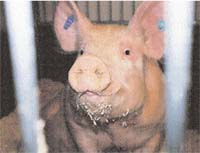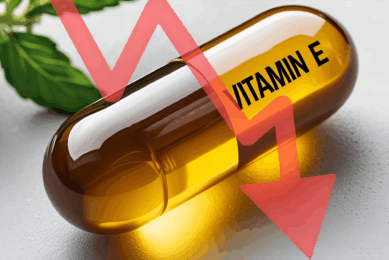Don’t ignore the boar! Minerals and vitamins for breeding boars

The boar is the most neglected animal on the pig unit according to the authors of a new book “The Nutrition of Sows and Boars”, published by Nottingham University Press. In this extract from Chapter 11, “The Boar”, a thorough review is given of the mineral and vitamin requirements of the working boar, and illustrates the need to examine the nutrition of boars more closely.
By WH Close and DJA Cole
| The boar is the most neglected animal in the pig unit |
The nutrition of the boar has received scant attention. Information relating to the nutritional requirements and responses of the breeding boar is therefore limited and this topic received little mention in the reviews of ARC (1981) and NRC (1988, 1998). Many recommendations have therefore been based on the breeding sow. If boars are to be reared for breeding purposes, then physical soundness and future reproductive performance are as important as good growth rate. Young boars are normally selected according to an index which includes such characteristics as growth rate, appetite, feed conversion efficiency, lean tissue growth rate, carcass quality and breeding potential. They are normally fed to appetite and it is assumed that this does not prejudice subsequent reproductive capacity. It may however affect their physical ability to perform since the tendency to leg weakness may be exacerbated by high rates of growth and by feeding to appetite (Grondalen, 1974; Hanssen and Grondalen, 1979; Kesel et al., 1983). Penny and Guise (1989) reported that the annual culling rate of boars in commercial herds is 40-60%, with the primary reason being excessive weight gain and animals becoming too large. This suggests that the priorities for nutrients and the nutritional requirements of the breeding boar may differ markedly from those bred for meat production or from those of the breeding sow. It is therefore important to establish the nutritional requirements and responses of the breeding boar at the various stages of development, to assess whether nutrition influences sexual development and reproductive capacity, and to make recommendations on appropriate feeding strategies to ensure good reproductive performance.
Nutrition until puberty
Under normal conditions, boars attain puberty between 5 and 8 months of age, when they weigh 80-120kg bodyweight. Age is more important than bodyweight in determining the onset of puberty (Einarsson, 1975). There may be differences in the age of attainment of puberty, and Sellier et al. (1973) and Kim et al. (1976) have shown that crossbred boars reach puberty earlier than their pure-bred counterparts by as much as 40 days. When rearing boars, the objective is, therefore, to allow them to attain puberty at a normal rate rather than to stimulate the precocious attainment of sexual development.
Requirements for minerals
Calcium (Ca) and phosphorus (P) are the most important minerals to consider in the nutrition of the working boar as they are crucial not only to optimise growth rate but also bone ineralisation, and hence the overall soundness of the limbs. There has been an increase in leg abnormalities in boars over the last 25 years, including joint abnormalities and lesions on the heel and toes, partly attributable to nutrient inadequacies (Gronalden, 1974). However, the incidence of leg weakness (osteochondrosis) varies between different breeds (van der Wal et al.1987), making precise recommendations for mineral requirements more difficult.
It is generally accepted that higher dietary levels of Ca and P are required for optimum bone mineralisation than for maximum performance during the growth processes of the boar (Hickman and Mahan, 1980). Hines et al. (1979) recommended concentrations of 9.3 and 7.5 g/kg of Ca and P, respectively, in the diet for maximal bone development but only 5.5 and 4.5 g/kg for growth. Similarly, Hickman et al. (1983) found that in young boars the requirements for Ca and P were higher than recommended by NRC (1979). Kornegay and Thomas (1981) and Kornegay et al. (1981) also found that maximum bone development occurred at Ca and P levels of 1.25 the NRC (1973) recommendations for mineral requirements of 6.5 and 5.0 g/kg respectively, during the growing phase, and 5.0 and 4.0 g/kg respectively, during the finishing phase. However, in the former study, little effect of dietary calcium and phosphorus on foot soundness and toe lesions was observed, although the number of toe cracks was reduced in animals fed 1.25 and 1.5 times the NRC recommendations for Ca and P levels in the diet. More recently, Lio Chung Wen (1996) showed that the best growth performances of growing boars were achieved when the diet contained 10 g Ca/kg and 8 g P/kg. However, for optimum bone mineralisation the requirements had increased to 12.5 g Ca/kg and 10.0 g P/kg.
Soundness of limbs is an important index to consider as foot-related problems are a major contributory factor to the loss of libido and inability of the boar to mount a sow or dummy. Kesel et al. (1983) reported that boars which had been fed 150% of the NRC (1973) recommendations for dietary Ca and P had heavier and thicker-walled metacarpals with greater bone strength than boars fed 100% of the recommendations. The weight, size, thickness, strength and ash content increased with age, with a small decline in the rate of increase, suggesting a reduction in the Ca and P requirements with age (Kornegay et al., 1981). This reduction with age may be less than that for breeding sows, and Liptrap et al. (1970) have shown that boars have significantly heavier bones with higher moment of inertia but with lower breaking stress values than gilts. Accordingly, for boars up to 50kg the dietary requirements for Ca and P should be set close to those suggested by Hines et al. (1979) of 9.5 and 7.5 g/kg, respectively. For boars above 50 kg body weight and during their breeding life the requirements should be set at 7.0-7.5 and 5.5-6.0 g/kg, respectively. Thus, as the animal grows the Ca:P ratio should be within the range 1.3 to 1.5:1.
Zinc
There is no evidence to suggest that the Ca:P ratio is important in spermatogenesis or semen quality per se. In contrast, zinc does have an established role in spermatogenesis, since zinc deficiencies are implicated in retardation of the development of the leydig cells, a reduced response to leutenising hormone and reduced testicular steroidogenesis (Hesketh, 1982). A level of 100 mg/kg is therefore recommended.
Selenium
Both selenium and vitamin E serve as antioxidants in boar sperm and they influence testicular and/or spermatozoa development and subsequent sperm motility. A deficiency of either may therefore influence different aspects of the whole reproduction process and possibly the fertilisation of oocytes in the female. A recent study by Marin-Guzman et al. (1997) has demonstrated the importance of dietary selenium for boar fertility. They fed boars a basal diet supplemented with either 0.5 ppm Se or 220 IU vitamin E/kg. Semen from adult boars fed the Se-supplemented diet produced greater volumes and concentrations of sperm which had higher motility than from boars fed the vitamin E-supplemented diet. There was no decline in sperm motility in the 16 week period of the trial as well as fewer abnormal sperm. In addition, the sperm from the boars fed the Se-supplemented diet had higher fertilisation capacity which resulted in the fertilisation rate of inseminated gilts also being higher (Table 1).
The results demonstrated that an adequate supply of dietary selenium is essential for the proper development of spermatozoa and for optimising the fertilisation rate of gilts and sows. Vitamin E does not entirely replace Se. A deficiency of Se gives a greater reduction than vitamin E and supplementation of Se gives a greater response. Similar to the growing and finishing pig, a dietary inclusion rate of 0.3 ppm Se is recommended for boars.
Chromium
Although not allowed in some countries, it may be advisable to add 200 ppb chromium to boar diets. Chromium is involved in many metabolic processes within the body, for example, it is the glucose tolerance factor and it stimulates the action of the hormone insulin. It has also been shown to enhance sperm count and fertility in male rats and has been shown to reduce stress in a range of animal species. It may therefore increase the reproductive potential of the boar.
Boars show no additional requirements for the other major minerals in relation to sows and the recommended mineral requirements for growing or breeding boars are shown in Table 2.
Requirements for vitamins
It has been suggested that the working boar has no additional vitamin requirements above those of the average breeding sow (adjusted according to maintenance requirements). However, the role of biotin in the diet of boars is becoming increasingly important as a result of its association with foot lesions and the attendant implications this has for reproductive performance in the boar. There is also an indication that vitamins E and C may be of special importance in the diet of stress-susceptible breeds. The vitamin requirements for both the growing and breeding boar are presented in Table 3.
Biotin
Biotin is an essential water-soluble, sulphurcontaining vitamin, which although widely distributed in nature, is present in relatively small concentrations, and has a limited bioavailability. The symptoms associated with deficiency of biotin in the diet of pigs include reduced growth rate, hair loss, dry scaly skin, spasticity of the hind limbs, erosion of the soft toe heel and extensive cracking of the toe heel and horn (Kornegay, 1986). Foot and toe lesions are generally associated with lameness, and an increase in foot abnormalities in pigs over the last 25 years has been reported (van der Wal et al., 1987), due in part to the poor conditions of housing and poor floor surfaces. Supplementation of the diet with biotin has been shown to strengthen the hoof significantly (Webb et al., 1984). It was initially shown that experimentally induced deficiencies in both young pigs and sows produce hoof cracks and lesions that are responsive to biotin supplementation. Similarly, foot lesions in sows housed in confinement can be reduced, although not completely prevented, by adding biotin to diets containing commonly-used feed ingredients (Penny et al., 1980; Bryant et al., 1985a, b).
The precise mode of action of biotin in the prevention of foot lesions is still uncertain. It is known that biotin increases the compressive strength and hardness of the hoof wall whilst decreeing the hardness of the heel bulb tissue (Webb et al., 1984). A soft heel bulb presumably acts as a cushion, minimising stresses and absorbing strain energy. In view of the noted effects on leg weaknesses and foot lesions on the ability of the boar to mount a sow and on its libido, the supplementation of biotin to the diet is a potential route whereby overall reproductive performance could be increased.
However, under current production systems, where boars are frequently housed on poorly-designed floors, the animals are unlikely to recover since the extent of the injury may exceed the capacity of the hoof for growth and repair. This indicates that certain problems experienced by the working boar need to be addressed at the more practical level of housing rather than that of nutritional status or dietary supplementation. Despite this, it is suggested that diets for working boars contain at least 0.3mg biotin/kg, but if foot problems exist then this should be increased to 1mg/kg diet.
Vitamin E
The continuous selection of animals for faster growth may also have resulted in an increase in the incidence of porcine stress syndrome. Stress-susceptible animals can undergo a fatal malignant hyperthermia when exposed to strenuous activities such as exercise and transportation. This frequently leads to mortality and a carcass condition known as PSE (pale soft exudative) meat which represents a considerable financial and management problem. In terms of their metabolic and biological status, stresssusceptible pigs under resting conditions are characterised by increases plasma activities of creatine kinase, pyruvate kinase and conjugated dienes and thiene barbituric acid reactive substances (Duthie and Arthur, 1987). These components are indices of cell membrane damage and lipid peroxidation and can be decreased by the addition of large quantities of vitamin E and selenium (potent antioxidants) to the diet.
Vitamin E functions as an antioxidant at the cell membrane and it has a structural role in all membranes. Hoppe et al. (1989) and Duthie et al. (1989) showed that the conditions responsible for stress-susceptibility are decreased when diets are supplemented with vitamin E. In addition, when fed in conjunction with increased dietary levels of selenium or vitamin C (an additional antioxidant) there may be an additional protective effect on cell membrane integrity. The specific importance of reducing stress-susceptibility in the working boar is related to its ability to perform. The excitement associated with mounting a sow or dummy may be sufficient to induce a fatal response in susceptible individuals and so where a particular stress-sensitive boar is used, supplementation of the diet with antioxidants could prove helpful. However, it may be better not to use such animals in order to prevent the inheritance of this trait throughout the herd.
Vitamin C (ascorbic acid)
It is generally assumed that pigs can synthesise adequate amounts of vitamin C to meet their metabolic needs (NRC, 1979). However, there is growing evidence that the pig’s requirement for vitamin C is increased under stressful conditions, such as changes in environmental conditions and when excessive handling occurs. In addition, increased concentration of vitamin C in semen helps to protect the sex cells from oxidative damage. Thus, working boars may benefit from supplemental vitamin C in their diet on the assumption that it improves metabolism resulting in better growth, improved feed conversion and better foot and leg structure (Riker et al., 1967). However, the results from studies on the merits of vitamin C supplementation are equivocal. Cleveland et al. (1987) failed to show any effects of supplemental vitamin C on performance traits or composite soundness scores of the foot and leg structure, although the straightness of the front legs was improved. Nielsen and Vinther (1984) reported more positive results since animals fed an additional 1g of vitamin C per day exhibited a lower incidence of bent and crooked front legs. Pigs given 700 ppm of vitamin C in their diet were found to have better locomotion scores compared with animals receiving 0 or 350 ppm (Nakano et al., 1983) but Strittmatter et al. (1977) had previously failed to detect any effects on overall joint or visual soundness in pigs receiving an additional supplement of 780 ppm vitamin C. Liu et al. (1990) provided 300 mg vitamin C per day and reported better semen quality with fewer abnormal sperm compared with non-supplemented boars especially in hot conditions. It is therefore not possible to make a definitive statement regarding supplemental requirements for vitamin C in the diet of the working boar, although a potential role cannot be ignored.
"The Nutrition of Sows and Boars" is available from Nottingham University Press priced £50. To order a copy, contact Simon Robinson. Tel: +44 (0)115 983 1011 Email: srobins@nup.com











